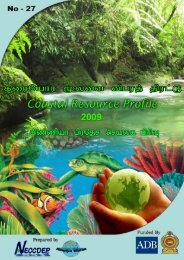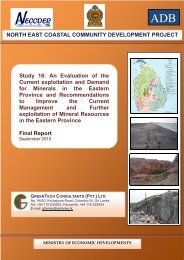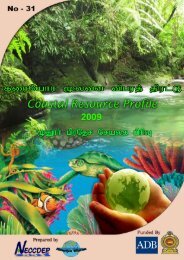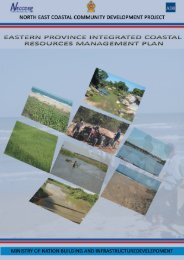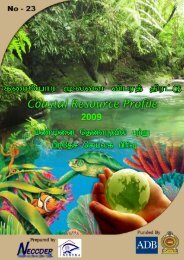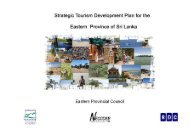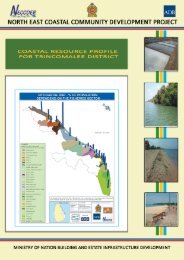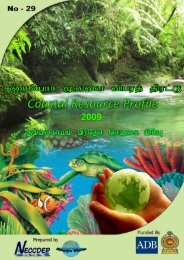Untitled - Neccdep.com
Untitled - Neccdep.com
Untitled - Neccdep.com
Create successful ePaper yourself
Turn your PDF publications into a flip-book with our unique Google optimized e-Paper software.
TRINCOMALEE BAY SPECIAL MANAGEMENT AREA Page | 13<br />
III.<br />
PREPARATION OF INTERIM SMA PLAN AND IMPLEMENTATION BY NECCDEP<br />
A. SMA process adopted in NECCDEP<br />
60. The <strong>com</strong>prehensive SMA planning process (currently the SAM planning process) can<br />
take several years. The CCC needs to be formed, made operational, strengthened and<br />
integrated into the wider stakeholder <strong>com</strong>munity. At least 1-2 years are also needed to<br />
<strong>com</strong>plete the data collection process and to <strong>com</strong>plete necessary studies such as<br />
participatory rural appraisal (PRA), development of resource profiles, water quality studies<br />
and other related studies. The <strong>com</strong>prehensive SAM Plan then needs to be developed in a<br />
consultative way that is gender sensitive and includes isolated and vulnerable stakeholders.<br />
61. In view of the timeframe and the delay in mobilizing the international consultants due<br />
to the poor security situation prevailing at the time, NECCDEP has adopted a parallel two<br />
track process involving the development of a fast-track interim SMA Plan and a slower more<br />
formal <strong>com</strong>prehensive SAM planning process. The development of resource profiles, water<br />
quality studies, tourism development studies follows the slower more formal <strong>com</strong>prehensive<br />
SAM planning process<br />
62. The fast track approach recognizes the precautionary principle “Noting also that<br />
where there is a threat of significant reduction or loss of biological diversity, lack of full<br />
scientific certainty should not be used as a reason for postponing measures to avoid or<br />
minimize such a threat” (Ref. 0121) . Waiting for several years to conserve the environment and<br />
bring benefits to local <strong>com</strong>munities may aggravate the situation by letting the environment<br />
deteriorate still further and losing the support of stakeholders due to lack of action.<br />
63. The NECCDEP “fast track” interim SMA planning approach focused on identifying and<br />
addressing priority issues through a work plan implemented during 2005-2006. The<br />
<strong>com</strong>prehensive slower SAM planning process continued in parallel. The <strong>com</strong>bined process is<br />
briefly listed below:-<br />
1. Review existing study and research reports;<br />
2. Start new studies to fill the gaps in information flow;<br />
3. Undertake a resource inventory and prepare the environmental profile;<br />
4. Identify core environmental issues;<br />
5. Undertake stakeholder workshops;<br />
6. Undertake field visits;<br />
7. Develop work plan 2005-2006;<br />
8. Form the SMA Committee (SMA C);<br />
9. SMA Committee approval of the work plan;<br />
10. Implementation of work plan through IP-NGO and IPs;<br />
11. Monitoring and evaluation;<br />
12. Formation of the District SAM Community Coordinating Committee<br />
(DSAM CCC);



